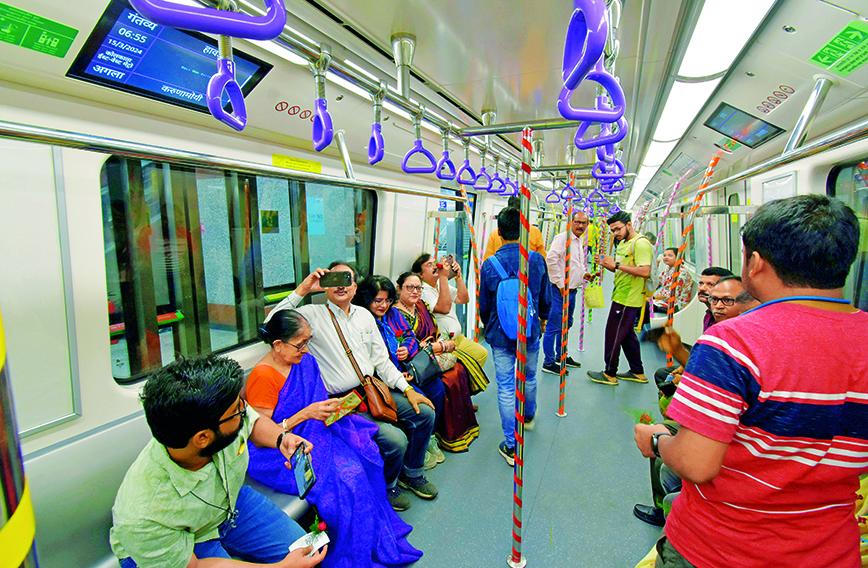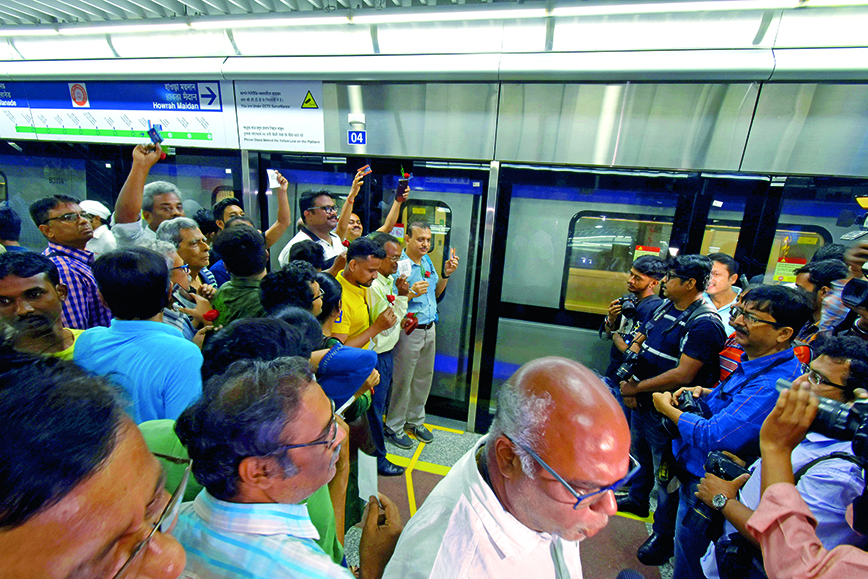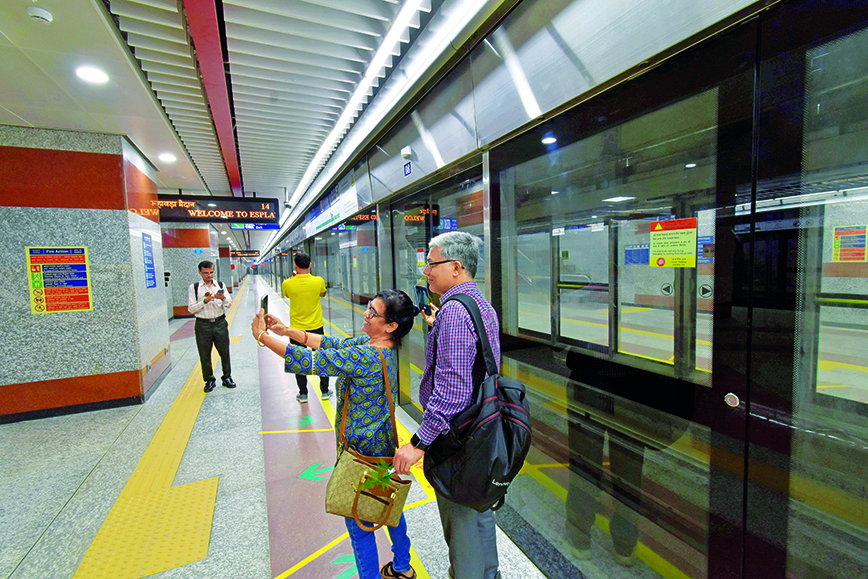
The real fun moment came when the train went under the river | Civil Society pictures/Ashoke Chakraborty
Happily to Howrah in the Metro under the Hooghly
Subir Roy, Kolkata
MID-March when the Kolkata Metro Rail’s service — linking Howrah Maidan to city centre Esplanade and touching in between the massive Howrah Station — began, the mood at the stations and in the trains was positively festive. Commuters who had queued up from early morning to take the 7 am first train that would go under the Ganga through a tunnel cheered and clapped as the journey began.
Railway staff greeted those in the ticket queues with rose stems. A college girl kissed her ticket when she got it and ran to her friends for a group selfie. In contrast, a mother and her 10-year-old daughter were crestfallen when they were unable to board the train because it was jam-packed.
For all, it was a dream come true. A commute that in a crowded bus across the equally crowded Howrah Bridge, which opened in 1943, would take an hour or more sometimes would now be done in under 10 minutes. A youngster in his mid-twenties confessed that he and his friends had sometimes thought that the much touted country’s first underwater rail link that they had been hearing about since their schooldays would never happen, what with construction work that dug up an important thoroughfare like the GT Road in Howrah going on and on.
 |
|
Metro staffers greeted commuters with roses |
On the second day of service, which was a Saturday, the rush was manageable with no more than ten minutes’ waiting in queues to get tickets. This gave a chance to coolheadedly assess the new service for its merits and demerits.
A gentleman in his early sixties provided one perspective when he recalled his first visit to Calcutta (as it was then called) half a century ago with his father. Then the two had crossed the river by tram and gone on by bus to visit the zoo.
He reflected a popular sentiment when he declared he was struck by what Indian engineers had been able to achieve today. He was equally disappointed by the fact that this had been done without paying adequate attention to how smoothly commuters could interchange between Howrah’s rail services and the Metro.
You have to walk what seemed like miles and cross a veritable battleground as construction work on one of the access points linking several floors below to the overground is still continuing.
Clearly, more escalators and lifts were needed. And what needed attention foremost was the signage, which is appalling. This is particularly so at the Esplanade station where those going on to the city from the Howrah line had to find their way to another line. Those who saved the day were Metro staff, quite a few of whom were around, ready to direct confused commuters.
The weekend semi-holiday crowd which was not entirely made up of office-goers with little time to stop and answer reporters’ queries, was enlivened by quite a few children who had been brought by parents to see this new big train that would go under the river! A mother and two children from another family had the time to pose for pictures.
The real fun moment came when the train went under the river. Beyond the train windows, the tunnel’s darkness was banished by blue lights.
 |
|
Commuters record the ride |
It brought forth bits of humour. One passenger urged others to notice how the hilsa fish jumped as the noisy train passed, another urged all to use the opportunity to fill up their pitchers with ganga jal.
Dipali Saha, a corporate executive turned social activist, who periodically used the London underground felt that the Kolkata Metro did not suffer in comparison. She particularly noted two improvements on the Kolkata Metro. There are far more escalators and, most importantly, washrooms for the public. And the Howrah Maidan station, she found, was particularly spacious with the exit she used not blocked by hawkers.
Her lone worry was that poor people will find the Metro a bit costly, compared to the bus or ferry fare. But well, she sighed, the Metro will, initially at least, be a goodie which only the middle class will be able to afford.
The Kolkata Metro may be the first in the country to go under a river but many others across the world have done so for long. London’s Metropolitan Railway Service began crossing the Thames underwater in 1863 and similar services make underwater crossings in Paris and New York.
But for a country and its people a first is a first and the authorities had the tunnel walls lighted up so that people could get a feel of things, even though the underwater segment of the 4.8-km journey between Howrah Maidan and Esplanade traversed the 520 metres in under 50 seconds.
Kolkata became the first city in the country to get a metro rail in 1984 though it covered a mere 3.4- km stretch with five stations. Today it covers a 35.8-km stretch with 28 stations that include the gigantic Howrah Station and the Howrah Maidan terminus.
Much as it is a unique distinction to have the Metro go under the Ganga, Metro Railway Kolkata has been notoriously slow throughout its entire history in going forward.
Work on it began in 1972 and the first visible sign of this was the disheartening one of the iconic Maidan in the heart of the city being dug up and, on the face of it, leading to ruin along its eastern length as work under the ‘cut and cover’ method progressed.
Citizens who had turned sceptics ever since the city began declining from the early 1960s ruefully wondered whether this was the last straw. The feeling was: we don’t know if and when we will get a metro rail and how useful it will be, but now the starkly visible sign is that it seems hell-bent on ruining the city's only green lung — the Maidan.
Today the scepticism is gone, buried under the Ganga and the Howrah station. In that sense the Howrah Maidan-Esplanade service is a symbol of a once great city, after a decline, having a rebirth.
Comments
Currently there are no Comments. Be first to write a comment!



